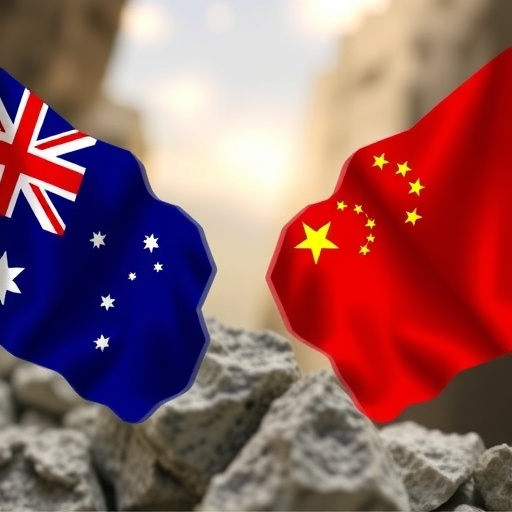U.S. and Australia Seal $8 Billion Critical Minerals Agreement to Counter China Dependency and Boost Economic Security
In a bold move to reshape global supply chains, the U.S. and Australia have signed a landmark agreement worth up to $8 billion, targeting the fortification of critical minerals production and processing. Announced during high-level talks in Washington, D.C., this pact aims to diminish reliance on China, which currently dominates over 80% of the world’s rare earth elements market, and enhance mutual economic security. As electric vehicles, renewable energy tech, and defense systems increasingly demand these scarce resources, the deal signals a strategic pivot toward allied partnerships in an era of geopolitical tensions.
- Unlocking the Deal: Core Elements of the U.S.-Australia Critical Minerals Pact
- Critical Minerals in the Spotlight: Powering the Green Revolution and National Defense
- Challenging China’s Dominance: Geopolitical Stakes in the Minerals Race
- Voices from the Frontlines: Industry Leaders and Policymakers React to the Agreement
- Paving the Path Forward: Long-Term Impacts on Global Supply Chains and Economic Security
Unlocking the Deal: Core Elements of the U.S.-Australia Critical Minerals Pact
The agreement, formally titled the U.S.-Australia Critical Minerals Security Initiative, commits both nations to a multifaceted collaboration spanning mining, refining, and recycling of essential materials like lithium, cobalt, nickel, and rare earths. Valued at up to $8 billion over the next decade, the funding will be split between public investments and private sector incentives, with the U.S. contributing approximately $4.5 billion through the Department of Energy and the Inflation Reduction Act’s green incentives, while Australia matches with $3.5 billion from its Critical Minerals Strategy.
Key provisions include joint ventures for new processing facilities in both countries. For instance, a $1.2 billion investment will establish a state-of-the-art lithium refining plant in Western Australia, capable of processing 50,000 tons annually, enough to power over 500,000 electric vehicles. In the U.S., funds will accelerate projects in Nevada and Texas, where untapped deposits of graphite and cobalt could meet 20% of domestic needs by 2030. The pact also emphasizes workforce development, allocating $500 million for training programs to upskill 10,000 workers in mining and advanced manufacturing.
“This isn’t just about digging deeper; it’s about building resilient chains that secure our future,” stated U.S. Secretary of Commerce Gina Raimondo during the signing ceremony. Australian Prime Minister Anthony Albanese echoed this, adding, “By partnering with the U.S., we’re turning our mineral wealth into a cornerstone of global economic security.” The agreement incorporates environmental safeguards, mandating sustainable practices to minimize ecological impacts, such as zero-waste recycling hubs projected to recover 70% of minerals from batteries by 2028.
To illustrate the scale, consider the numbers: Global demand for critical minerals is expected to quadruple by 2040, according to the International Energy Agency (IEA). Without diversified sources, supply bottlenecks could hike prices by 30-50%, crippling industries from smartphones to fighter jets. This agreement positions Australia, the world’s top lithium producer with 52% of global reserves, as a pivotal ally for the U.S., which imports 100% of its rare earths.
Critical Minerals in the Spotlight: Powering the Green Revolution and National Defense
At the heart of this agreement lies the indispensable role of critical minerals in modern economies. These 50-plus elements, including lithium for batteries, neodymium for wind turbines, and tantalum for electronics, underpin the transition to net-zero emissions and bolster military capabilities. The U.S. Geological Survey identifies 35 minerals as critical to its economy and security, with shortages posing risks to everything from Tesla’s Gigafactories to Lockheed Martin’s F-35 jets.
Take lithium, for example: Demand surged 200% in the last five years, driven by the EV boom. Australia supplies 55% of the world’s lithium, but raw ore exports to China for processing leave both nations vulnerable. Under the new pact, integrated supply chains will localize refinement, potentially cutting U.S. import costs by 25% and creating 5,000 high-wage jobs in Australia‘s Pilbara region alone.
Beyond energy, critical minerals are vital for defense. Rare earths enable precision-guided munitions and radar systems; the Pentagon estimates a 300% increase in demand by 2030. The agreement includes a defense-specific clause, funding $800 million for secure sourcing of gallium and germanium, materials China restricted in 2023, causing semiconductor prices to spike 15%.
- Lithium and Cobalt: Essential for EV batteries; Australia holds 20% of global cobalt reserves.
- Rare Earths: Used in magnets for drones and missiles; joint R&D will boost extraction efficiency by 40%.
- Nickel: Key for stainless steel and alloys; new facilities aim to double U.S. production to 100,000 tons yearly.
Environmental integration is a highlight: The pact mandates adherence to the Paris Agreement, with carbon-neutral mining pilots using AI-optimized drilling to reduce water usage by 30%. This addresses criticisms of past extractive practices, ensuring the critical minerals rush doesn’t exacerbate climate change.
Challenging China’s Dominance: Geopolitical Stakes in the Minerals Race
The U.S.–Australia agreement emerges against a backdrop of escalating tensions with China, which controls 60% of global mining output and 85% of processing for critical minerals. Beijing’s export curbs on graphite in 2023 and ongoing trade frictions have exposed vulnerabilities, prompting Washington to invoke the Defense Production Act for domestic stockpiling. This pact is part of a broader “friendshoring” strategy, aligning with the Quad alliance (U.S., Australia, Japan, India) to counterbalance China’s Belt and Road mineral investments in Africa and South America.
Statistics underscore the urgency: The U.S. risks a $50 billion annual hit to GDP if critical minerals supplies falter, per a 2023 Rand Corporation report. Australia, facing its own export dependencies, sees the deal as a hedge; its government projects a 15% GDP boost from value-added processing. By rerouting flows away from China, the partners aim to stabilize prices—lithium carbonate, for instance, fluctuated 400% in 2022 due to supply fears.
Geopolitically, this strengthens AUKUS ties, the 2021 security pact encompassing nuclear submarines. Minerals now extend that framework economically, with shared intelligence on supply risks. “We’re not isolating China; we’re diversifying for resilience,” noted Australian Trade Minister Don Farrell. Critics, however, warn of potential retaliation, as China could flood markets with cheap exports, undercutting new facilities.
Broader context includes EU and Canadian parallels: The EU’s Critical Raw Materials Act mirrors this approach, while Canada’s $3.8 billion mineral fund eyes similar U.S. pacts. Yet, the U.S.–Australia tie stands out for its scale, potentially inspiring a “minerals NATO” for collective bargaining power.
Voices from the Frontlines: Industry Leaders and Policymakers React to the Agreement
The signing has elicited widespread praise, with stakeholders hailing it as a game-changer for economic security. Tesla CEO Elon Musk tweeted, “Fantastic step toward secure, sustainable supply chains—vital for accelerating the EV revolution.” In Australia, BHP Group, the world’s largest mining firm, committed $2 billion in matching funds, with CEO Mike Henry stating, “This agreement unlocks Australia’s potential as a green minerals powerhouse, creating jobs and cutting emissions.”
U.S. policymakers are equally enthusiastic. Senator Joe Manchin, chair of the Energy Committee, called it “a bipartisan win against foreign overreach,” emphasizing how it aligns with the CHIPS Act’s $52 billion semiconductor push. Environmental groups like the Sierra Club offered cautious support, praising sustainability clauses but urging stricter oversight: “We need to ensure this doesn’t repeat the mistakes of coal-dependent mining.”
Economists project ripple effects: A Moody’s analysis forecasts 15,000 new jobs across both nations, with U.S. manufacturing output rising 10% in battery sectors. Challenges persist, though—Indigenous communities in Australia‘s Northern Territory demand greater involvement, citing past land disputes. One Yolngu leader remarked, “Minerals are our ancestors’ gift; profit-sharing must honor that.”
International reactions vary: Japan, a Quad partner, expressed interest in tripartite extensions, while Chinese state media labeled the pact “protectionist.” Overall, the consensus is optimistic, with the World Bank estimating such alliances could stabilize global prices by 20% within five years.
Paving the Path Forward: Long-Term Impacts on Global Supply Chains and Economic Security
Looking ahead, the U.S.–Australia agreement sets the stage for a more secure era in critical minerals. By 2035, joint projects could satisfy 40% of U.S. demand domestically or via allies, slashing vulnerability to disruptions like the 2022 Ukraine war’s nickel shortages. Innovations in recycling—targeting 90% recovery rates—will circularize economies, reducing raw extraction needs by half.
For economic security, this fortifies alliances: Enhanced trade under the pact could add $20 billion to bilateral flows, per U.S. Trade Representative estimates. It also spurs R&D, with $300 million for battery breakthroughs, potentially yielding solid-state tech that doubles EV range.
Challenges loom, including regulatory hurdles and market volatility, but next steps are clear: Implementation begins Q1 2024, with pilot plants operational by 2025. As climate goals intensify—net-zero by 2050 demands 10x more minerals—this agreement not only secures supplies but redefines economic security in a multipolar world. Stakeholders anticipate follow-on deals with Canada and the UK, weaving a resilient web against future shocks.
In essence, this pact transcends bilateral ties, embodying a proactive stance on the minerals frontier where innovation meets strategy.










